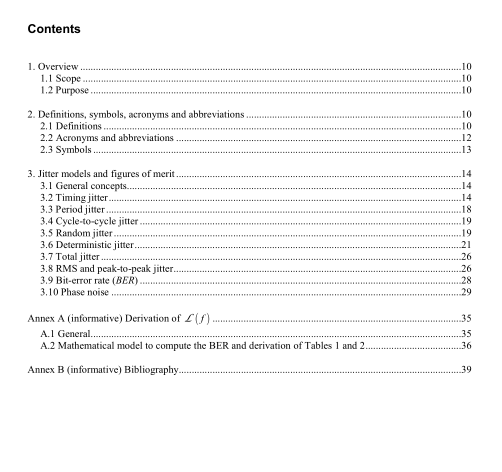IEEE 2414-2020 pdf download.IEEE Standard Jitter and Phase Noise
3. Jitter models and figures of merit
3.1 General concepts
Jitter is a general term that describes a phenomenon consisting in the deviation of the reference instants of a sequence of events from their ideal values. Jitter may be interpreted in several ways, as will be discussed in this standard, depending on the practical effect of interest and its application.
Jitter has many different physical sources. However, from a behavioral point of view, jitter can be modeled by means of statistical distributions, time trends, and frequency domain analysis of event reference instant deviations. Jitter appears either on ideally periodic signals, like those generated by clock sources and sine wave generators; inherently non-periodic signals, like baseband digital signals; or in general repetitive signals that include asynchronous events.
It is the features and instants in a waveform that are amenable to measurement and analysis and, hence, the reference to waveform characteristics in this standard. The word “actual” when it refers to a waveform or its features is used to indicate the measured or acquired waveform or its features.
3.2 Timing jitter
When the jitter specifically affects signals that are intended to provide a timing reference, such as clock signals or sync signals, it is called timing jitter. The following subclauses provide specific mathematical symbols and models.
It is worth noticing that when the effect is due to long-term phenomena, the term wander is used instead. The boundary between short-term and long-term phenomena is conventionally placed, in this context, at 10 Hz in the power spectral density (see 3.5.1 for details). Timing jitter is the deviation of the actual reference instants associated with a timing waveform with respect to their ideal values.
Timing jitter provides a measure of the short-term instability of the timing circuit. Timing jitter is characterized by means of its spectral properties, its statistical distribution in time or its time trend. In these two last cases, timing jitter shall be expressed in units of time or in unit interval (UI). The amplitude of the timing jitter is defined as the range of deviations of the actual reference instants of a timing waveform from their ideal values.
The example shown in Figure 1 presents a case of timing jitter induced by additive amplitude noise on the timing signal. In this figure, the noisy positive-going transition of the waveform crosses the detection threshold over a range of reference instants that deviate from the ideal reference instant. Note that only one threshold crossing is detected per repetition of the transition.
3.2.1 Timing error
The timing error (TE) is the difference between the actual reference instant of an event and its ideal value,and is given by Equation (1):
where
is the reference instant of the nth occurrence of an event
is the ideal reference instant of the nth occurrence of the same even
is the timing error
For example, timing error quantifies the delay or advance of the instant of the actual transition of a signal compared to its ideal transition instant (IEC 61280-2-3:2009 [B11]). To measure , TE n J , , id n t must be either known or estimated (EN 60679-1:2007-06 (P9450) [B3]). Therefore, the estimation of , TE n J requires the comparison of n t with the , id n t for a reference clock (Figure 2). The reference clock synchronization and/or strobe signal is transmitted or not. In the latter case, a clock and data recovery is required (Teledyne Lacroy (2014) [B31]).
3.2.1.1 Timing deviation The timing deviation (TDEV) provides an estimate of the deviation of the actual reference instants from the ideal reference instants for a given periodic event. Given a total number of N repetitions of the event, a subset is extracted by taking one occurrence out of every L. TDEV estimates the variability of TE J versus L by means of Equation (2) (from ITU-T G.810, SERIES G [B13]):
TDEV also provides information about the spectral content of the phase (or time) noise of the signal, as explained in ITU-T G.810, SERIES G [B13].IEEE 2414 pdf download.IEEE 2414-2020 pdf download
IEEE 2414-2020 pdf download

Leave a Reply